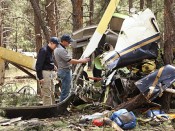What is the FAA doing to prevent EMS helicopter crashes?
The average number of EMS helicopter crashes continues to trend upwards. In 1990, there was one helicopter accident involving EMS with no fatalities, according to National Transportation Safety Board (NTSB) records. In 1994, there were four helicopter crashes and six fatalities. In 1998, 11 accidents and eight fatalities. In 2004, the worst year yet, there were 19 EMS helicopter crashes, 29 deaths, seven major injuries, and three minor injuries.
Most of these accidents happened at night or during bad weather. And most involved crashing into the ground, the side of mountains, and other types of terrain.
Generally speaking the Federal Aviation Administration (FAA) is responsible for providing oversight to the EMS helicopter and airplane industry. But the reality is that the Administration does not have the resources to inspect all operators effectively – and the number of operators is growing every year. Not surprisingly, most of their efforts are focused on the airline industry. So what is the FAA doing to help combat the rising number of accidents?
FAA Releases Preliminary Fact Sheet
On June 30, 2008 the FAA released a Fact Sheet entitled “EMS Helicopter Safety.” In this document, the agency states that it will not be making any new rules (though it states it may do so in the future) but instead wants to prompt “significant short-term safety gains that do not require rulemaking.” These include:
- Encouraging risk management training
- Suggesting better pilot training for night flights
- Suggesting better pilot training for bad weather conditions
- Promoting technology use
- Providing “airline-type FAA oversight”
Unfortunately, many experts suspect that without sufficient rulemaking, the first four of these points will largely go unheeded. The last point may simply be impossible because the number of FAA inspectors is actually shrinking nationwide; any inspectors assigned to EMS helicopter safety will have to come from some other sector in the industry.
It doesn’t take an aviation expert to realize that with rising fuel costs and increased competition, independent operators will be looking to cut costs wherever possible. And that means not investing in night vision goggles and other fancy gadgets, or extra training beyond what the law demands.
Further, because the industry is growing so rapidly, the quality of pilots may be watered down. Instead of the best 100 flying in the air, the cut-off mark may be now the best 1,000.
When you take all these factors into account, it is not surprising that there are so many EMS helicopters crashes.
Are FAA Actions Really “Actions”?
As part of the June 2008 Fact Sheet, the FAA lists a number of “actions” it has taken to help reduce the number of accidents. However, some might say they are not so much actions as panel discussions, advisories, recommendations, and lists of best practices. The only thing approaching a concrete action to regulate the industry is the formation of the Aviation Rulemaking Committee (ARC), which is “considering” areas of change.
But things that might really make a difference like a mandatory Terrain Avoidance Warning System (TAWS) to help warn pilots before they hit the ground or a mountain are being approached slowly. On the one hand, the FAA states that it “supports the voluntary implementation of (TAWS)” but on the other says that it doesn’t want to mandate them yet. Because helicopters generally fly lower to the ground, nuisance warnings “could negatively impact the crew’s response to a valid alert.”
It is true that the FAA is collecting research on systems specifically designed for helicopters, so-called H-TAWS. But with EMS helicopter flights becoming as dangerous as military flights in battle, you might think the process should be speeded up.
Regardless of FAA’s actions or inactions, the bottom line is that the operator is responsible for your safety during an EMS. This includes the actual EMS company, as well as possibly the hospitals who requested the flight, other helicopter operators involved in an accident, and other possible parties as well. Finding out who is to blame for your injuries can quickly become a complicated matter.
Call David P. Willis for a free case assessment if you or a loved one has been injured in an EMS helicopter accident. No matter where you are located in the country, we may be able to help you get the compensation you deserve to cover medical costs, lost wages, pain and suffering, and more. At the very least, you will have a better understanding of your rights and a good idea of the compensation you may be entitled to. With this information, you will be able to make a more informed decision.
Contact a Helicopter Lawyer
If you have been injured or a loved one has been killed in a helicopter crash, then call us 24/7 for an immediate consultation to discuss the details of the accident and learn what we can do to help protect your legal rights. Whether the accident was caused by negligence on the part of the helicopter owner, hospital or corporation, the manufacturer or due to lack of training, poor maintenance, pilot or operator error, tail rotor failure, sudden loss of power, defective electronics or engine failure or flying in bad weather conditions, we can investigate the case and provide you the answers you need. Call Toll Free 1-800-883-9858 and talk to a Board Certified Trial Lawyer with over 30 years of legal experience or fill out our online form by clicking below:


